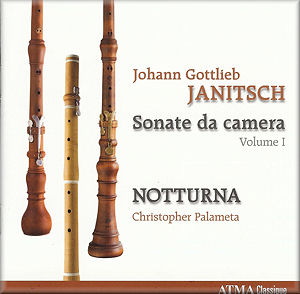 |
 |
|


alternatively
CD:
AmazonUK
AmazonUS
Download: Classicsonline
|
Johann Gottlieb
JANITSCH (1708-1763)
Sonate de camera - Volume 1
Sonata da camera in G minor [17:27]
Sonata da camera in C minor, Op.5 [12:31]
Sonata da camera in C major, Op.4 [13:08]
Sonata da camera in E minor, Op.5B [11:56]
Sonata da camera in A minor, Op.5A [12:31]
 Notturna: Christopher Palameta
(oboe, oboe d’amore), Stephen Bard (oboe),
Mika Putterman (baroque flute), Hélène Plouffe (violin, viola),
Kathleen Kajioka (viola), Karen Kaderavek (cello), Erin Helyard (harpsichord) Notturna: Christopher Palameta
(oboe, oboe d’amore), Stephen Bard (oboe),
Mika Putterman (baroque flute), Hélène Plouffe (violin, viola),
Kathleen Kajioka (viola), Karen Kaderavek (cello), Erin Helyard (harpsichord)
rec. 1-3 March, 2008, Église Saint-Augustin, Mirabel (Québec)
 ATMA ACD2 2593 [67:55] ATMA ACD2 2593 [67:55]  |
|
|
Born in Silesia, Johann Gottlieb Janitsch flourished as one
of Frederick II’s ‘stable’ of court musicians.
He was a member of Frederick’s orchestra as the violinist
Johann Gottlieb Graun, his brother the cellist Carl Heinrich,
the violinist Franz Benda, the great flautist Johann Joachim
Quantz and, of course, C.P.E. Bach. Like many of Frederick’s
Berlin musicians, Janitsch was both accomplished instrumentalist
(he played the contraviolon) and a composer. There is a valuable
section on him in Michael O’Loghlin’s Frederick
the Great and His Musicians, 2008. A good deal of Janitsch’s
music has been lost although some manuscripts which disappeared
from Berlin at the end of the Second World War recently turned
up in the Ukraine.
Janitsch served Frederick from 1736 until the year of his death,
1763. Towards the end of that lengthy period - mostly spent
in Berlin - from about 1758 Janitsch began to organise weekly
chamber music concerts (every Friday afternoon) at his apartment
behind the Jagerhof in Berlin. It was probably primarily for
such occasions that he composed his twenty-seven ‘quadro’ sonatas.
Of the five sonatas on this very pleasant CD, three (Op.5,
Op.5A and Op.5B) are receiving what appear to be their first
recordings. One of the attractions of these sonatas - and they
have a number - is that Janitsch writes for more or less unfamiliar
combinations of instruments. So the first sonata (the one without
an opus number) uses the oboe, the violin, the viola and continuo;
Opus 5 is for two oboes, viola and continuo; the Opus 4 sonata
is written for the oboe d’amore, two violas and continuo,
while Opus 5B deploys the oboe d’amore, two violas and
continue and Opus 5A is for flute, oboe, oboe d’amore
and continuo. The changing textures, and Janitsch’s obvious
fascination with the possibilities thus created give these
sonatas a very pleasing variety. This is a programme one can
readily listen to straight through. Add to such considerations
the fact that Janitsch has a genuine gift for melody and a
fondness for somewhat improbable harmonic shifts - as, for
example, in the Vivace of the quartet in A minor - and one
has music that is far from routine. A fondness for syncopation,
an obvious familiarity with the music of his Berlin colleague
C.P.E. Bach, serve to give to Janitsch’s music an essentially galant and
expressive manner which is very attractive.
The musicians of Notturna are very accomplished and the recorded
sound is good (the tone of Christopher Palameta’s oboe
and oboe d’amore being particularly well caught). It
is to be hoped that further volumes will follow. While the
world can hardly be full of people waiting eagerly for recordings
of the work of Janitsch (whose name has not made a previous
appearance on the pages of MusicWeb), this music which should
give real pleasure to anyone with an interest in the music
of the mid Eighteenth Century.
Glyn Pursglove
|
|
|

